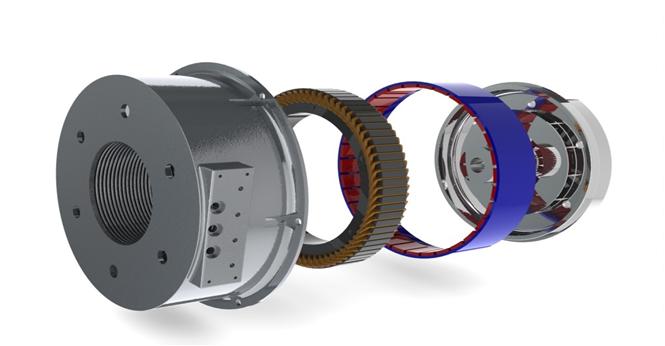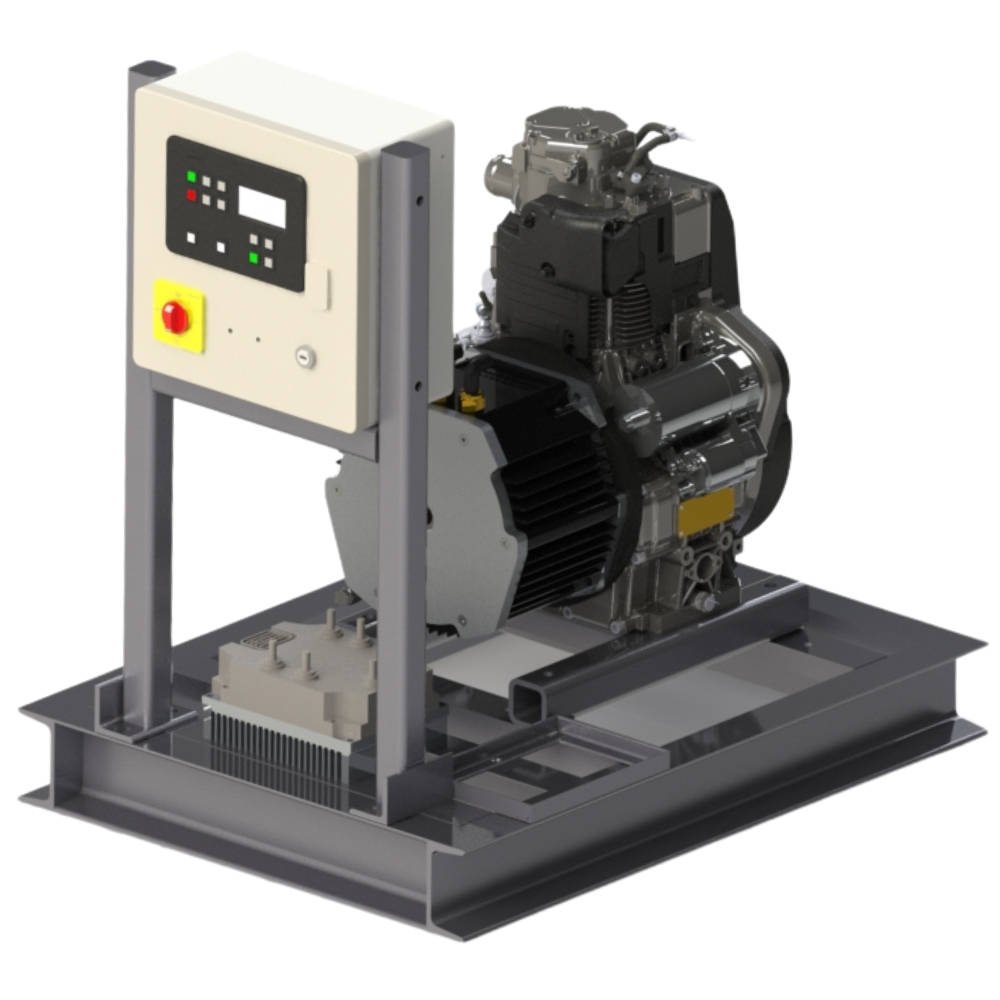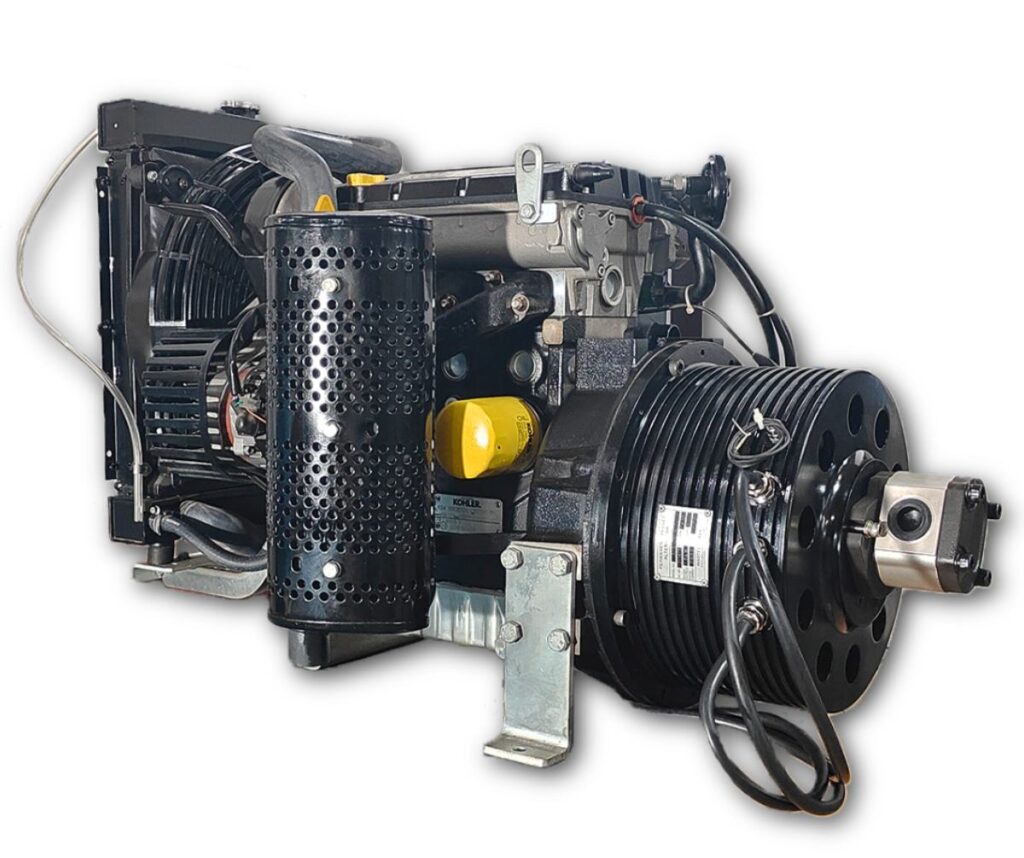
DC Generators
A Permanent Magnet Alternator is the core of a successful, fuel efficient DC generator Drivetrain. There are many advantages of Permanent Magnet DC Generator over the traditional induction alternator. Foremost, the fuel consumption is much lower and the maintenance servicing is spread much further apart. Standout points of comparison are the length, high efficiency, and the simple integration of operation. The new technology is overall superior to the old mechanics of the traditional alternator.
Open frame DC Genset

Open frame Genset with hydraulic pump

DC Generator: Efficiency
The DC Generator (DC-PMG) reduces operating expenditures by reducing the fuel consumed. A proprietary design was engineered and constructed and that reduces the electric ripple and maintains efficiency through a range of rpms. The peak efficiency is engineered over 93%. The alternator is coupled with the Smart DC controller which feeds the power into the battery bank or directly into the DC power load.
DC Generator: No Maintenance
The bearing less DC-PMG unit reduces wear and tear and does not require continuous maintenance. The design of the machine enables coupling to any housing layout and is capable of using any manufacturer’s driveshaft. The permanent magnet alternator has no bearings, slip rings, brushes, exciters, or attached diodes. This eliminates the areas prone to failure and increases the longevity of the product. Once it is installed, there are no routine maintenance requirements for the alternator. By providing variable speed functionality, the engine is always running at its ideal operating speed which provides optimum torque and a low vibration of the engine. MTBF: Over 80,000 Hours.
DC Generator: Compact
With a reduced length and diameter, the DC-PMG units are 30% less in size than traditional alternatives. The units compete in the greatest Power to Size and Power to Weight ratios worldwide.
DC Generator Models & Customized Options
235-EZ24-175
- 5 kW
- 24 Vdc
- 2300 RPM
- SAE 5 Housing
- Starter Motor Capability
310-DZ48-225
- 10 kW
- 48-56 VDC
- 2400 RPM
- SAE 5 Housing
- Starter Motor Capability
310-HZ48-350
- 16 kW
- 48-56 VDC
- 2200 RPM
- SAE 5 Housing
- Starter Motor Capability
310-AZZ48-350
- 18 kW
- 48-56 VDC
- 2000 RPM
- SAE 5 Housing
- Starter Motor Capability
Custom Options
- Up to 80 kW
- 12-1200 VDC
- Custom RPM
- SAE Matching
- Starter Motor Capability
Flywheel Alternators

DC Generator Guide
A whole system design is the first starting place in picking components for a DC Generator requirement. Questions to ask from a system design perspective:
What is the purpose of the power? Battery Charging or Continuous Power Supply?
Is the prime mover being used in a series hybrid model or does it have a dual/parallel function?
Defining the DC Generator Power Requirement
Let’s say you want to be able to do a 50 amp charging rate for a 48Vdc battery bank.Take the optimal charging voltage of the battery bank (ie. 56 Vdc) and multiply it by the charging amps desired (55Vdc x 50 amp = 2,750 Watts).
Output: Watt power requirement
Selecting the DC Generator Prime Mover
For the sake of this guide, we are focused on engines and turbines as prime movers. You need to work backwards from the amount of power you want to produce/or the amount of charge you want for your battery pack. Here you need to know the efficiency of other components in your system (DC Generator, Rectifier/Charge Controller). Let’s assume the total electrical/electronic components have an efficiency of 90%. Then, you would need the mechanical equivalent of 3,056 watts (2,750/.9 = 3,055.55). 3,056 watts is equal to 4.1 horsepower. Next, look at the the torque/efficiency/rpm curve of your prime mover. If you are using the prime mover solely for the DC generator, then where is the prime mover the most fuel efficient for the desired power output? If you are using the prime mover for charging and in parallel with a mechanical function, then will you have enough mechanical power for both at the running rpms? Will they be running simultaneously?
Output: Targeted RPM for peak loading conditions; Range of RPMs that the generator will be expected to charge
DC Generator Efficiency
When Innotec discusses DC Generator heads, we are really saying a 3 phase Permanent Magnet Alternator coupled with either an internal or external rectifier/charge controller. This is the most efficient and durable way to produce DC electrical output. It is critical to analyze the differences in products on the market with potential suppliers and manufacturers. There is a wide range of efficiencies available by manufacturers. To get a truly efficient operation, it is best to get a customized unit to match your running rpm and power/voltage requirement. Efficiency curves of alternators will have 2 primary variables the rpm and loading conditions.Matching the efficiency of the alternator to the specific rpm/load condition that you desire to operate at will be key to having the highest efficiency possible.
Output: Efficiency at the desired running rpm and power output; Mechanical sizes of the DC Generator
Passive versus Active Rectification and Charge Controlling
Controlling the output voltage will be critical for charging applications. This will secure the longevity of the system’s batteries and create the most efficient operation. Two ways to control the charging voltage:
(1) Use a passive rectifier while controlling the speed of the prime mover to adjust the voltage.
(2) Use active rectification, taking in a larger input voltage range to produce the necessary output voltage
Summarizing
These are a few of the first considerations when moving forward with a DC Generator project.
- What is the power requirement of the generator?
- Will the prime mover be used solely as a generator or in parallel with other mechanical functions?
- What is the prime mover suitable for this requirement?
- What is the optimal running speed for the generator? Does this maximize efficiency?
- Will an active or passive rectification system work best?
Read more information on DC Generator Heads
Read more information on 48V Alternators
Read more information on 24V Alternators
